It's 2017, and what better way to bring in the new year than with a pet who is healthy and happy! Many of us have made our New Year's resolutions to exercise and eat healthy, so why not add an extra one by helping our four-legged loved ones lose some extra poundage?
Obesity is a common condition we see here at Animal Hospital. What many pet owners don't know is that the “few treats” per day or the table scraps you give your pet can really add up, contributing to obesity and affecting their health. If we tell you your pet is overweight, we promise we’re not trying to place blame—we simply want what's best for your pet!
How to tell if your pet is overweight
When your pet comes in for a physical exam, one of the factors we assess is their weight and their body condition. Body condition refers to where they are on a scale, from emaciated to normal to obese. We use a scale of 1-9, with normal weight being a 4 or 5 out of 9.
When you look at your dog, assess them from the top and from the side. From the top, look for a “waist” to tuck in behind the ribs, and from the side, the belly should tuck up. If you gently press on your dog over the ribs and shoulders, there shouldn’t be a thick layer of fat that you can feel under the skin. If you can feel skin, maybe a thin layer of fat, and then the ribs, that’s perfect. If you can see ribs and hip bones sticking out, your pet may underweight, though the start of the rib outlines may be just visible in short-haired dogs, especially the back ribs by the belly.
Mamba, Nicole’s German Shepherd, is modeling an appropriate body condition (5/9 on the body condition scale) in these photos. You can see some muscle definition, and her waist tucks in nicely.
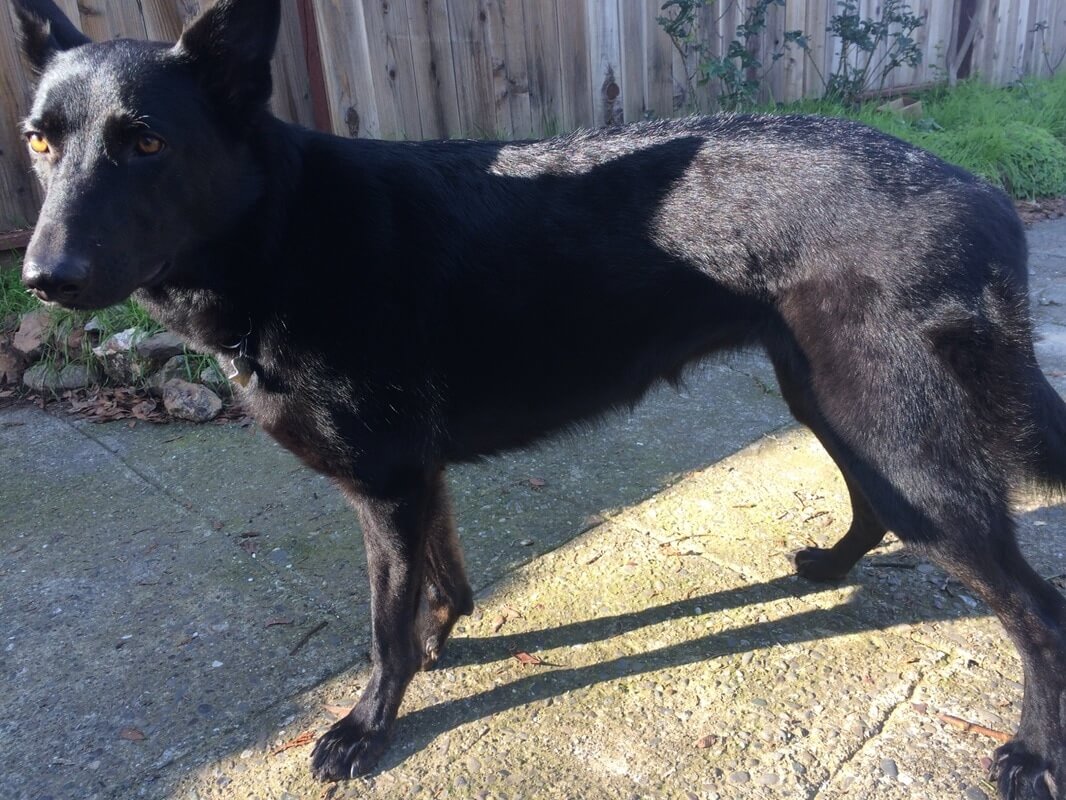
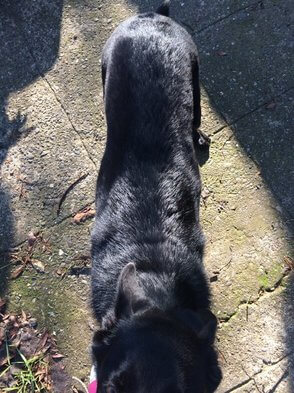
For cats, they like to accumulate fat in their belly and the fat pad that hangs under their belly. Similar to a dog, there should be a straight line or a waist apparent if you look from the top, but from the side the skin hanging down will hide their belly. As far as weight, cats are much less variable than dogs, so we can give general guidelines. Your average house cat will likely be between 9 and 12 pounds, so if your cat is significantly over or under that range, ask us if they are too thin or overweight.
See the “before” and “after” photos below of Iris, Dr. Stambaugh’s cat—she went from 19 pounds to 11 pounds, and you can see how much her belly shrank!
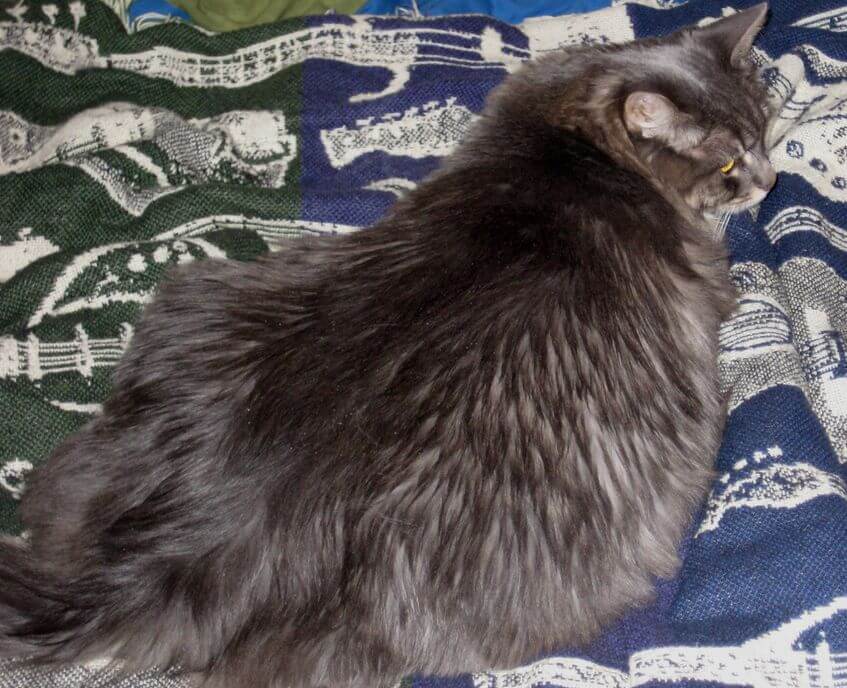
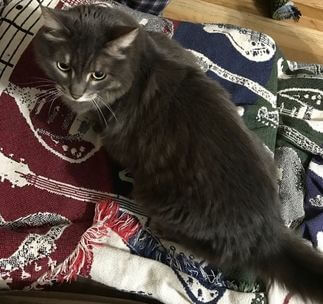
Tips for achieving (and maintaining!) a healthy weight:
Controlling Calories

In most cases portion control and limiting treats are enough to control a pet’s weight; in particular, cutting out table scraps and decreasing the amount of treats can be big steps forward in are weight loss goals. Treats have a lot more calories then most pet parents think! As far as portion control, “about a cup” means different things to different people, and is not consistent from day to day. Using a measuring cup helps owners know how much they are feeding each day, and helps different family members all be on the same page regarding how much to feed. Ask us for a free measuring cup for your pet’s kibble!

Do you know how much you should be feeding in the first place? Fortunately most pet food bags have a daily feeding guide that you can follow based on age and desired weight. Be aware, though, that these guidelines are usually on the high end of the recommendations; if your dog is older, not very active, or has a slower metabolism (such as can occur in spayed or neutered dogs), they likely won’t need as much food as the bag suggests.
For some overweight pets, particularly those with insatiable appetites and a lot of weight to lose, a specific weight-loss food may be called for. There are many “weight control” formulas available in pet stores, which are generally lower-calorie versions of popular pet foods. There are also prescription weight-loss foods available, either from our office or by prescription, which are specially formulated to provide fewer calories while still providing enough essential nutrients, as well as being designed to let pets still feel full and satisfied.
Exercise
The other part of reaching and keeping a healthy weight is exercise. Now, we understand that this takes some time out of your day and you guys are busy, but there are many ways to exercise your pet. For dogs, you can set aside time when you get home to take your dog for a walk, or make your daily walks just a little bit longer. If you can’t go for a long walk yourself, maybe you can play fetch in the backyard each day.
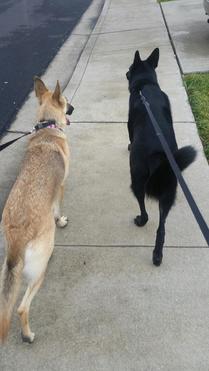
For cats, placing their food on a cat tree can encourage them to climb, or you can use a food-dispensing toy to make meal-time a game. You can use a laser-pointer or a ribbon-on-a-pole type cat toy to encourage play. You can set short term goals on how you would like to approach the situation and how you can fit an exercise time into your daily schedule, and adjust to what works for you and your pet. Working out together can be just as enjoyable for your pet as it is for you, providing them mental stimulation as well as physical activity, and creating a closer bond between you two.
Combining both exercise and a diet plan can help your pets achieve their ideal weight. To make sure you’re on the right track, you can bring your pet into the office every couple of weeks or so to weigh them on our scale and keep track of their progress. Let our receptionist know that’s what you’re doing, and they’ll note it in the medical record and tell you if your pet has lost weight. If they don’t drop the pounds, or if they start out strong and then stabilize at a new, but still not ideal weight, the regular weight-checks will let you know that you need to decrease the calories and increase the exercise a little more.
Let us know if you have any questions about your pet’s weight, and how to help manage it! Our goal is for you and your pet to have a long, active life together, and weight management is a great way to get there.
